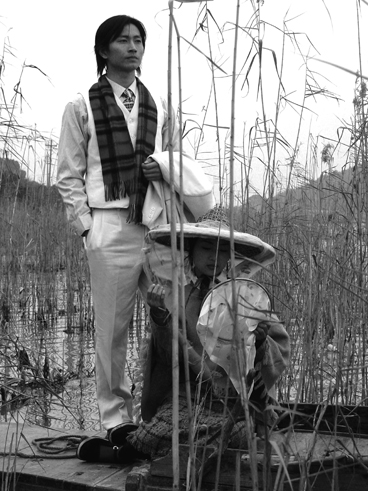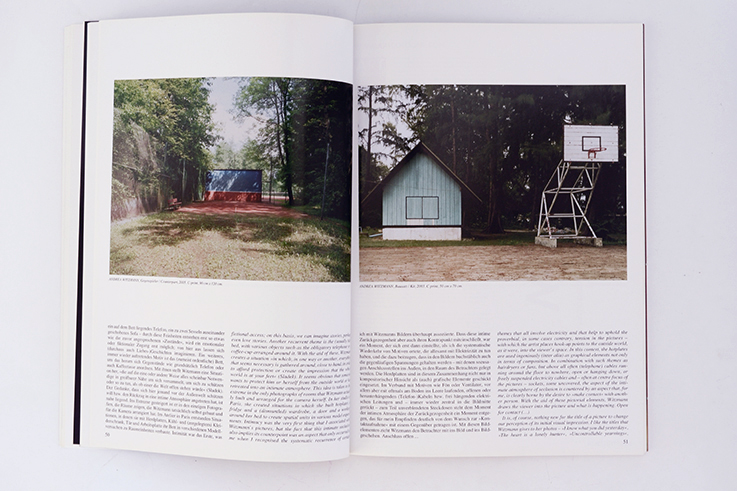Camera Austria International
91 | 2005
- MASASHI KOHARA
A Portrait of Takuma Nakahira - TAKUMA NAKAHIRA
- IRIS DRESSLER
Marco Poloni: If You See Something, Say Something - MARCO POLONI
- HIAS WRBA
Yang Fudong: Thresholds - YANG FUDONG
- MAREN LÜBBKE-TIDOW
Andrea Witzmann: 220 Volt - ANDREA WITZMANN
- TOM HOLERT
Mass-Media Acts (4)

Preface
In summer this year, as part of the “Chikaku Time and Memory in Japan” exhibition cureted by Toshiharu Ito (a project in co-operation with Kunsthaus Graz and Japan Foundation), Camera Austria presented works of Takuma Nakahira, publisher of Provoke magazine, one of the pioneers of contemporary Japanese photography together with Daido Moriyama, theorist and artist. Since his “rediscovery” at his retrospective show at the Yokohama Museum and the monograph published by Osiris in 2003, his current works have once again come to the fore in the debate about the possibilities of describing reality with the aid of photography. His now legendary early work reflects the political and social change of Japan in the 1960s and conveys an aesthetic impression of his doubts about bringing about social change by means of artistic and publicistic work. In his essay, the Japanese art theorist Masashi Kohara discusses Nakahira’s political, theoretical, artistic, but also biographical milestones.
Read more →Camera Austria International 91 | 2005
Preface
In summer this year, as part of the “Chikaku Time and Memory in Japan” exhibition cureted by Toshiharu Ito (a project in co-operation with Kunsthaus Graz and Japan Foundation), Camera Austria presented works of Takuma Nakahira, publisher of Provoke magazine, one of the pioneers of contemporary Japanese photography together with Daido Moriyama, theorist and artist. Since his “rediscovery” at his retrospective show at the Yokohama Museum and the monograph published by Osiris in 2003, his current works have once again come to the fore in the debate about the possibilities of describing reality with the aid of photography. His now legendary early work reflects the political and social change of Japan in the 1960s and conveys an aesthetic impression of his doubts about bringing about social change by means of artistic and publicistic work. In his essay, the Japanese art theorist Masashi Kohara discusses Nakahira’s political, theoretical, artistic, but also biographical milestones.
The focus of Marco Poloni’s work is on our trust in the supposed ability of the image as a valid representative of reality, but also the modes of perception pre-informed by culture and the media. He explores the many facets of this subject in his works – serial photographic works that he refers to as scripts or storyboards for films. In her essay, Iris Dressler focuses on the artist’s recent works, for example “Permutit – Storyboard for a Film”, which featured at the Swiss pavilion at this year’s Venice Biennial. Although Poloni’s cinematic photo series appear to be staged, he does not work with any actors or props. He presents nothing but real situations and yet creates profoundly fictional narrative and pictorial spaces that oscillate between deception, imagination and reality.
The works of the Shanghai-based artist Yang Fudong, in contrast, are lavishly enacted and are similar to classical Chinese cinema of the 1930s and 1940s, both aesthetically and in terms of content. His attention is often focused on the actors? gestures, movements and looks. In his work, Yang Fudong attempts to track down the changes and non-simultaneities in modern Chinese society that are due, above all, to the country’s rapid economic developments and the contingent social change. This was a good opportunity for our author Hias Wrba to examine the artist’s pictorial compositions more closely in his contribution.
Enactment is a term that may also be associated with the documentary, direct photographic works of the Austrian artist Andrea Witzmann. Her works provide insights into spaces that sometimes appear to be ordered as if by an invisible hand. There are no or few people in these pictures, even in the landscapes. Objects that betray the presence of a person are equally rare, with the interior situations remaining objective on the surface and seemingly devoid of history. In her contribution, Maren Lübbke-Tidow sets out to track down Witzmann’s strategy, that allows the viewer an emotional access by intentionally placing details, but also by introducing poetical, associative captions, tempting him to dive into the intimate seclusion of these picture stories.
In the fourth and final instalment of his series of essays “Mass media acts: On Visual Programming of the Political Space”, Tom Holert discusses the events connected with “Live8” and the terror attacks in London, exploring the question as to how pictures of moving crowds and individuals are used to mobilise a globalised public. We would like to thank Tom Holert for this enriching co-operation.
In conclusion, we would like to invite you this autumn once again to visit Camera Austria at the fair stands at the Frieze Art Fair in London, the Art Forum in Berlin, and at Art Cologne.
Christine Frisinghelli
Entries
Forum
DANIEL BARTHMANN
SABINE SCHRÜNDER
LUKAS SCHALLER
ANNALISA SONZOGNI
KLAUS MOSETTIG
STEFAN PASSIG
CHRISTIAN HAGEMANN
NATHALIE MOHADJER
SACHIGUSA YASUNDA
Exhibitions
51. Biennale di Venezia: Länderpavillons
Arsenale, Venedig
MAREN LÜBBKE-TIDOW
Eine Erfahrung des Widerstandes
51. Biennale di Venezia: The Experience of Art.
Italienischer Pavillon
REINHARD BRAUN
51. Biennale di Venezia: Always a Little Further
Arsenale, Venedig
MANISHA JOTHADY
Gustav Metzger: Geschichte Geschichte
Generali Foundation, Wien
ANDREAS SPIEGL
On Differenz # 1.
Württembergischer Kunstverein, Stuttgart
SØNKE GAU
Alice Creischer – Appart zum osmotischen Druckausgleich von Reichtum bei der Betrachtung von Armut
GAK Bremen
KERSTIN BRANDES
Trisha Donnelly
Kölnischer Kunstverein
JOHANNA DI BLASI
Urbane Realitäten: Fokus Istanbul.
Martin-Gropius-Bau, Berlin
KRYSTIAN WOZNICKI
Fouad Elkoury: Fotografien und Filme.
Städtische Galerie im Lenbachhaus, München
ANNETT BUSCH
Arbeit*
Galerie im Taxispalais, Innsbruck
NINA SCHEDLMAYER
Nach Rokytnik – Die Sammlung der EVN.
Museum Moderner Kunst Stuftung Ludwig
LUISA ZIAJA
Police.
Landesgalerie Linz am Oberösterreichischen Landesmuseum, Linz
MAREN RICHTER
Jeff Wall: Photographs 1978 – 2004
Schaulager, Basel; Tate Modern, London
BARBARA KUNZ
Artur Zmijewski.
Kunsthalle Basel
KIRSTY BELL
Friedlander.
Museum of Modern Art, New York; Haus der Kunst, München
Leaps of Faith.
Nicosia
DENISE ROBINSON
Photoespaña: Ciudad. VIII. Festival International de Fotografía y Artes Visuales.
Madrid
MANUEL OLVEIRA
Might it just be that time passes? David Claerbout.
Kunstbau der Städtischen Galerie im Lenbachhaus, München
YOANN VAN PARYS
The Politics of Pleasure. Back to Black: Art, cinema and the racial imaginary.
Whitechapel Art Gallery, London; The New Art Gallery, Walsall
DENISE ROBINSON
IX. Baltic Triennial of International Art
WALTER SEIDL
Books
Put About: A Critical Anthology on Independent Publishing.
Book Works, London 2005
KIRSTY BELL
Polaroid asl Geste – Über die Gebrauchsweisen einer fotografischen Praxis.
Hatje Cantz Verlag, Ostfildern-Ruit 2005
CAROLIN FÖRSTER
Claire Denis: Trouble Every Day.
Synema, Wien 2005
ANNETT BUSCH
Reinhard Matz: Fassade. Köln.
Emons-Verlag, Köln 2005
WOLFGANG VOLLMER
Slavko Kacunko: Closed Circuit Videoinstallationen. Ein Leitfaden zur Geschichte und Theorie der Medienkunst mit Bausteinen eines Künstlerlexikons auf DVD.
Logos Verlag Berlin, Berlin 2005
ANDREA DOMESLE
Linda Herzog: Birmingham – Instanbul – Zürich. Alltag in der städtischen Wirklichkeit.
Passenger Books, Köln/Zürich 2005
GISLIND NABAKOWSKI
Imprint
Publisher: Manfred Willmann. Owner: Verein CAMERA AUSTRIA, Labor für Fotografie und Theorie
All: Lendkai 1, A-8020 Graz
Editors Graz: Reinhard Braun, Christine Frisinghelli, Manisha Jothady
Editor Berlin: Maren Lübbke-Tidow
Copy editing: Marie Röbl
Translations: Wilfried Prantner, scheid&scheid, Richard Watts















